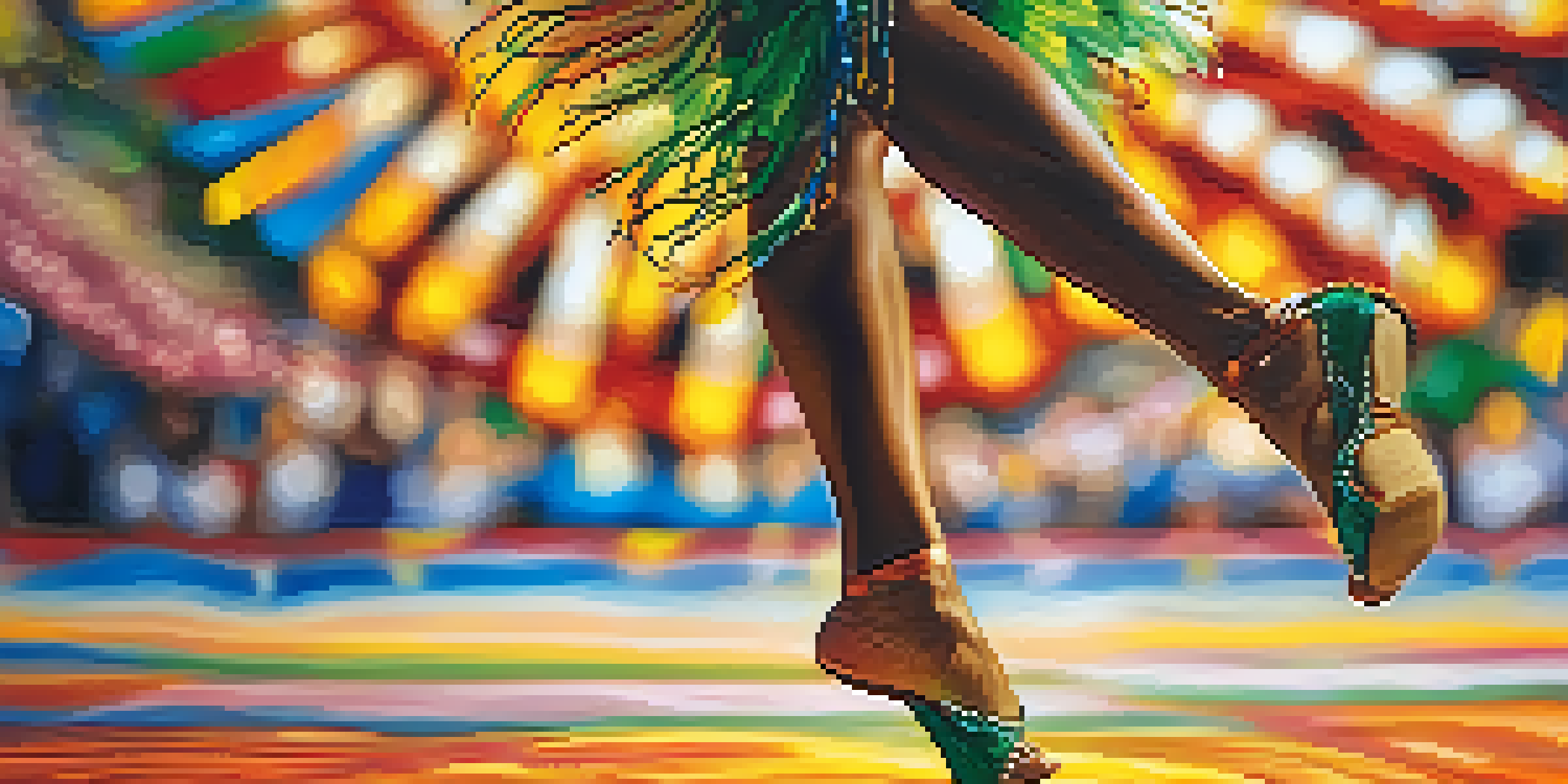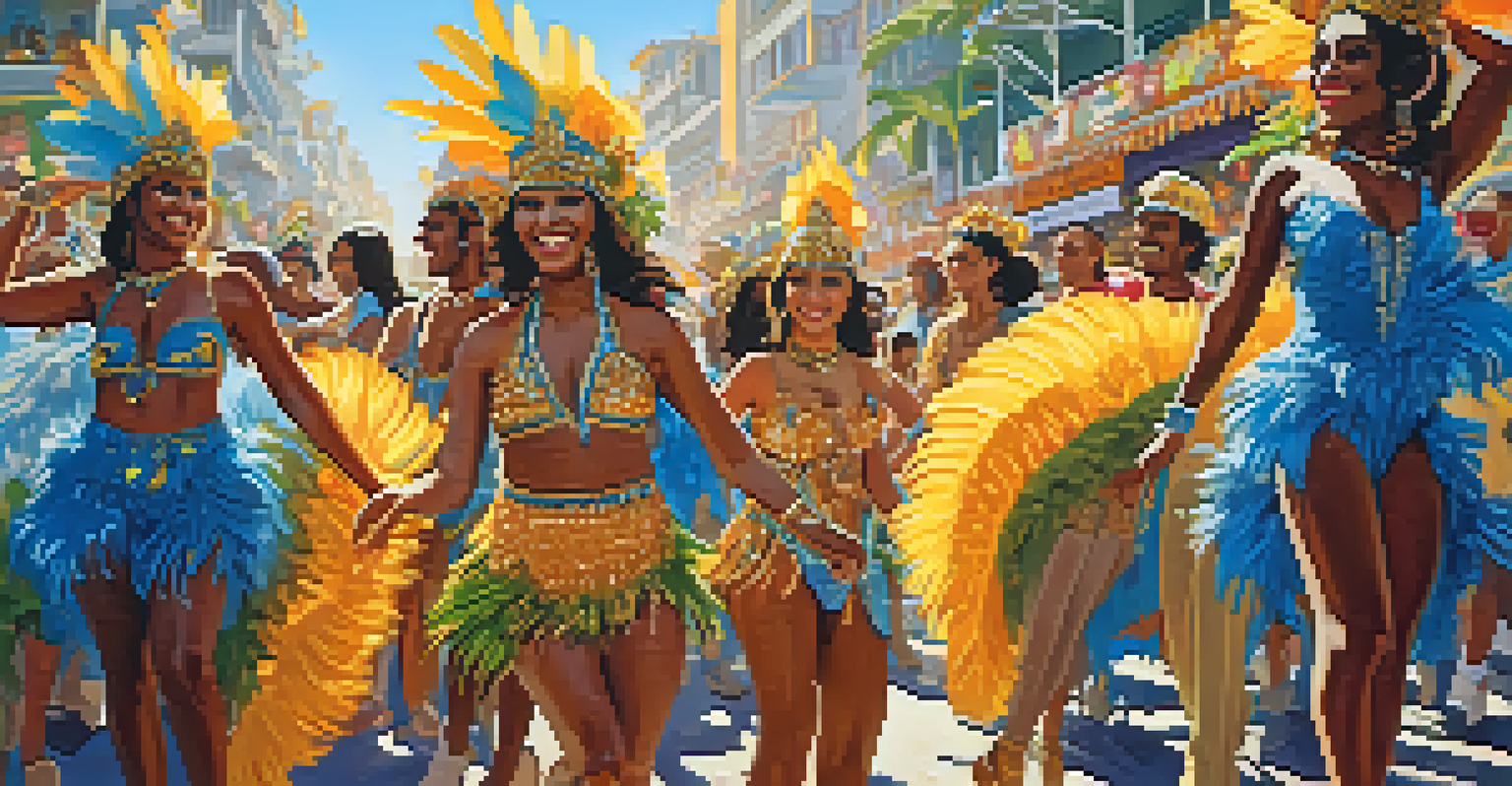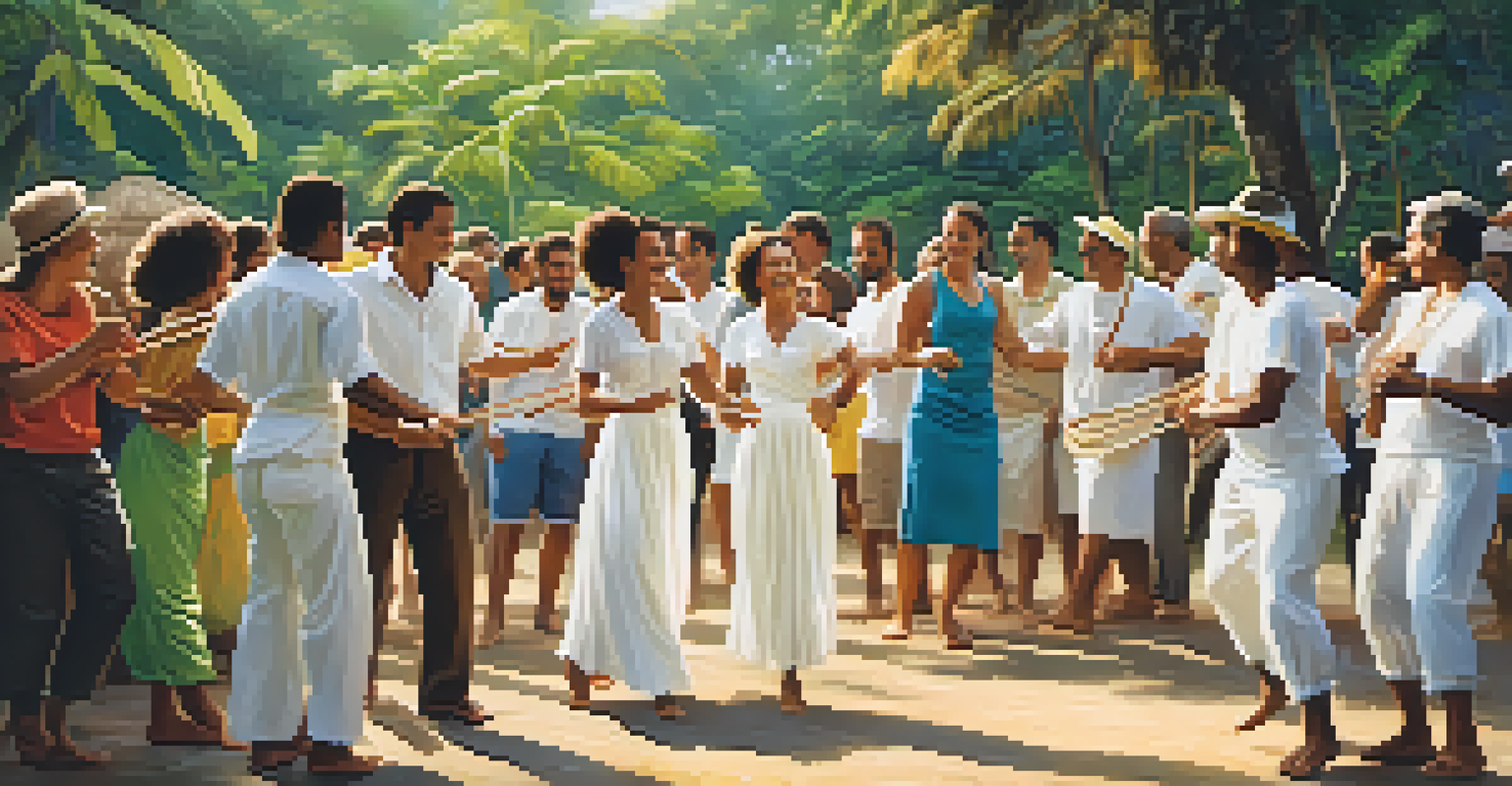The Roots of Samba: A Journey Through Brazil's Dance History

The Origin of Samba: A Cultural Melting Pot
Samba's roots can be traced back to the early 20th century in Brazil, a time when the country was a blend of various cultural influences. The dance originated from African rhythms brought by enslaved people, mixed with Brazilian and European elements. This fusion created a unique sound and movement that would eventually evolve into the Samba we know today.
Samba is not just a dance; it's a celebration of life and culture.
In its earliest form, Samba was performed in the streets during festivals and celebrations, showcasing the vibrant spirit of communities. The lively beats and energetic movements captured the essence of Brazilian life, making it a symbol of joy and resilience. Over time, Samba transcended its local origins, captivating audiences far beyond Brazil's borders.
The dance and music of Samba reflect the struggles and triumphs of its people, serving as a powerful reminder of cultural identity. As it grew in popularity, Samba became a vital part of Brazil's national identity, celebrated in carnivals and other festivities. Today, it stands not just as a dance, but as a rich tapestry of history and cultural significance.
The Evolution of Samba: From Street to Stage
As Samba gained popularity, it began to evolve from informal street performances to more structured stage presentations. In the 1930s, the first Samba schools were established, providing a platform for dancers and musicians to showcase their talents. These schools became central to the development of Samba, creating a community focused on preserving and innovating the art form.

The annual Carnival in Rio de Janeiro emerged as a pivotal moment for Samba, offering a grand stage for competition and creativity. Samba schools would compete in elaborate parades, showcasing their best dancers, musicians, and floats, turning the streets into a vibrant spectacle. This transformation not only elevated Samba as an art form but also solidified its place in Brazilian culture.
Samba's Rich Cultural Roots
Samba originated from a blend of African rhythms and Brazilian influences, reflecting the resilience and identity of its people.
Through this evolution, Samba adapted to various influences, incorporating elements from jazz, bossa nova, and even rock. This adaptability has allowed Samba to remain relevant and exciting, continually attracting new generations of enthusiasts. Today, Samba is celebrated globally, inspiring dance and music lovers around the world.
Samba's Connection to African Heritage
At the heart of Samba lies a deep connection to African heritage, reflecting the traditions and customs of enslaved Africans in Brazil. The dance incorporates rhythms and movements that tell stories of struggle, celebration, and community. This connection serves as a reminder of the resilience of African culture and its profound impact on Brazilian identity.
Dance is the hidden language of the soul.
Many Samba styles, such as Samba de Roda, directly trace their roots to African rituals and communal gatherings. These traditional dances emphasize the importance of community and togetherness, showcasing how Samba is more than just a dance—it's a way of bringing people together. This communal aspect is still evident in today's Samba performances, where the audience often joins in the celebration.
Samba's ties to African heritage also extend to its music, featuring instruments like the berimbau and atabaque, which are integral to the sound of traditional Samba. By honoring its roots, Samba continues to celebrate and elevate African contributions to Brazilian culture. This connection not only enriches the dance but also serves as a powerful reminder of the importance of cultural heritage.
The Role of Samba in Brazilian Identity
Samba is often viewed as the heartbeat of Brazilian culture, embodying the country's spirit of joy and celebration. It plays a crucial role in shaping national identity, representing the diverse influences that make Brazil unique. From its origins in the streets to its prominence in Carnival, Samba has become a symbol of unity and pride for Brazilians.
Throughout history, Samba has been a medium for social commentary, addressing issues such as inequality and injustice. Many Samba songs reflect the struggles of marginalized communities, using the dance as a form of protest and expression. This aspect of Samba highlights its importance not just as entertainment, but as a voice for the people.
Evolution from Streets to Stages
Samba transformed from informal street performances to structured stage presentations, becoming a vital part of Brazilian culture.
Moreover, Samba has transcended borders, influencing global music and dance genres. Its infectious rhythms and vibrant movements have inspired artists and dancers worldwide, showcasing the power of cultural exchange. As Samba continues to evolve, it remains a key element of Brazil's national narrative, celebrated both at home and abroad.
Different Styles of Samba: A Diverse Dance Form
Samba is not a one-size-fits-all dance; it comes in various styles, each with its unique flavor and history. From the traditional Samba de Roda, characterized by its circular movements, to the fast-paced Samba no Pé, which is a solo dance performed during Carnival, each style tells a different story. This diversity within Samba reflects the rich tapestry of Brazilian culture.
Another notable style is Pagode, which emerged in the 1980s from the favelas of Rio de Janeiro. Pagode incorporates elements of humor and social commentary, often performed in informal settings like backyard parties. This style has made Samba more accessible, allowing people from all walks of life to enjoy and participate in the dance.
These different styles not only showcase the versatility of Samba but also highlight how it continues to evolve. As new generations of dancers and musicians emerge, they infuse their creativity into the dance, ensuring that Samba remains relevant and vibrant. This ongoing evolution keeps the spirit of Samba alive, inviting everyone to join in the celebration.
Samba in Modern Culture: Television and Beyond
In recent years, Samba has made its mark in modern culture, particularly through television and film. Shows featuring Samba music and dance have captivated audiences, bringing the joy of this Brazilian art form to homes worldwide. This exposure has helped elevate Samba as a cultural phenomenon, attracting newcomers eager to learn and participate.
Social media platforms have also played a significant role in the resurgence of interest in Samba. Dancers share videos showcasing their skills, inspiring others to join the movement. This digital age has allowed Samba to reach a global audience, uniting people through the universal language of dance and music.
Global Appeal of Samba
Samba's infectious rhythms and movements have inspired a worldwide dance movement, fostering cultural exchange and celebration.
Moreover, events like the Rio Carnival have adapted to modern trends, incorporating elements of technology and design. These innovations not only enhance the visual appeal of performances but also keep the tradition alive for younger generations. As Samba continues to thrive in modern culture, it proves that the dance is not just a relic of the past, but a living and evolving art form.
The Global Influence of Samba: A Worldwide Dance Movement
Samba's infectious rhythms and lively movements have transcended Brazil's borders, inspiring a global dance movement. Dance schools around the world now offer Samba classes, allowing people from diverse backgrounds to experience the joy of this vibrant art form. This international interest has led to a rich exchange of cultural practices and ideas.
Festivals celebrating Samba are held in various countries, showcasing performances that highlight its global appeal. Events like the Notting Hill Carnival in London and the Sydney Mardi Gras feature Samba prominently, reflecting how this dance has become a symbol of multicultural celebration. These festivals not only honor Samba's Brazilian roots but also foster connections among diverse communities.

As Samba continues to spread worldwide, it maintains its core values of joy, unity, and cultural pride. The global embrace of Samba serves as a reminder of the power of dance to bring people together, regardless of their backgrounds. Through its evolution and adaptation, Samba remains a beloved art form, continuously inviting everyone to join in the celebration.